
Recently, during a coffee break, emerged a discussion about the presence of probability and statistics in top journals such as Annals of mathematics, Acta Mathematica, Inventiones Mathematicae, or Journal of the AMS. Well, the question has an interest from the point of view of the sociology and history of science. Let us use the Primary and Secondary Mathematical Subject Classification (MSC) codes of each article in order to detect Probability (60x) or Statistics (62x). Here is the data from MathSciNet/zbMath:
- Annals of Mathematics published 4464 papers in total from 1938 to 2019.
Among them, 76 (1.7%) have Primary MSC 60x [PDF]
Among them, 112 (2.5%) have Primary or Secondary MSC 60x [PDF]
Moreover only 2 have Primary or Secondary MSC 62x [PDF] - Acta Mathematica published 1297 papers in total from 1938 to 2017.
Among them, 44 (3.4%) have Primary MSC 60x [PDF]
Among them, 63 (4.9%) have Primary or Secondary MSC 60x [PDF]
Moreover only 4 have Primary or Secondary MSC 62x [PDF] - Inventiones Mathematicae published 4311 papers in total from 1966 to 2019.
Among them, 52 (1.2%) have Primary MSC 60x [PDF]
Among them, 95 (2.2%) have Primary or Secondary MSC 60x [PDF]
Moreover only 2 have Primary or Secondary MSC 62x [PDF] - Journal of the AMS published 963 papers in total from 1988 to 2019.
Among them, 28 (2.9%) have Primary MSC 60x [PDF]
Among them, 49 (5.1%) have Primary or Secondary MSC 60x [PDF]
Moreover only 5 have Primary or Secondary MSC 62x [PDF]
The presence of probability is low, while the one of statistics is microscopic. A scandal.
AO(P|S). Annals of Probability (AOP) and Annals of Statistics (AOS) were founded only in 1973.
1938. Annals of Mathematics is historically American whereas Acta Mathematica is European. They started respectively in 1892 and 1882. According to MathSciNet, it seems that the first article classified 60x in these journals was published in 1938. The MSC by itself was introduced at the end of the thirties and many articles in MathSciNet are not classified before 1940 at the time of writing. Note that N. Wiener published in the twenties while A. N. Kolmogorov published in the thirties.
Why. The phenomenon has probably multiple explanations, among them we could mention for instance the possible effects of utilitarism and anti-utilitarism in the mathematical elite, in particular during the fifties and sixties, and the possible overweight of some kind of "snobish pure mathematics or mathematicians" in top journals boards. We could also see AOP and AOS as some sort of mathematical ghettos and think about self-censorship. We could moreover think about generational effects. Finally we have to keep in mind that some probability papers were published without any primary or secondary 60x code, such as for instance this one or that one.
Here is some additional data provided by MathSciNet for Annals of Mathematics:
| MSC | Description | Count |
|---|---|---|
| Other (includes unclassified papers before 1940) | 1626 | |
| 14 | Algebraic geometry | 319 |
| 57 | Manifolds and cell complexes | 298 |
| 20 | Group theory and generalizations | 292 |
| 11 | Number theory | 288 |
| 53 | Differential geometry | 262 |
| 46 | Functional analysis | 207 |
| 58 | Global analysis, analysis on manifolds | 203 |
| 56 | Other | 200 |
| 32 | Several complex variables and analytic spaces | 174 |
| 55 | Algebraic topology | 172 |
| 10 | Number theory | 159 |
| 22 | Topological groups, Lie groups | 149 |
| 30 | Functions of a complex variable | 135 |
| 35 | Partial differential equations | 126 |
| 42 | Harmonic analysis on Euclidean spaces | 111 |
| 37 | Dynamical systems and ergodic theory | 107 |
| 09 | Other | 100 |
| 60 | Probability theory and stochastic processes | 76 |
| 54 | General topology | 51 |
| 27 | Other | 47 |
| 36 | Other | 43 |
| 12 | Field theory and polynomials | 40 |
| 49 | Calculus of variations and optimal control; optimization | 39 |
| 17 | Nonassociative rings and algebras | 35 |
| 47 | Operator theory | 35 |
| 02 | Logic and foundations | 33 |
| 05 | Combinatorics | 32 |
| 52 | Convex and discrete geometry | 32 |
| 34 | Ordinary differential equations | 31 |
| 81 | Quantum theory | 26 |
| 28 | Measure and integration | 25 |
| 16 | Associative rings and algebras | 22 |
| 03 | Mathematical logic and foundations | 21 |
| 13 | Commutative algebra | 20 |
| 40 | Sequences, series, summability | 20 |
| 18 | Category theory; homological algebra | 19 |
| 83 | Relativity and gravitational theory | 19 |
| 31 | Potential theory | 18 |
| 43 | Abstract harmonic analysis | 17 |
| 19 | K-theory | 13 |
| 82 | Statistical mechanics, structure of matter | 13 |
| 90 | Operations research, mathematical programming | 12 |
| 06 | Order, lattices, ordered algebraic structures | 11 |
| 41 | Approximations and expansions | 11 |
| 15 | Linear and multilinear algebra; matrix theory | 10 |
| 33 | Special functions | 10 |
| 26 | Real functions | 9 |
| 48 | Other | 8 |
| 45 | Integral equations | 7 |
| 76 | Fluid mechanics | 7 |
| 04 | Set theory | 6 |
| 39 | Difference and functional equations | 6 |
| 70 | Mechanics of particles and systems | 6 |
| 00 | General | 3 |
| 68 | Computer science | 3 |
| 44 | Integral transforms, operational calculus | 2 |
| 62 | Statistics | 2 |
| 73 | Mechanics of solids | 2 |
| 01 | History and biography | 1 |
| 21 | Other | 1 |
| 71 | Other | 1 |
| 79 | Other | 1 |
| 80 | Classical thermodynamics, heat transfer | 1 |
| 84 | Other | 1 |
| 94 | Information and communication, circuits | 1 |
The same for the last three years :
| MSC | Description | Count |
|---|---|---|
| 11 | Number theory | 29 |
| 14 | Algebraic geometry | 20 |
| 53 | Differential geometry | 17 |
| 05 | Combinatorics | 10 |
| 35 | Partial differential equations | 10 |
| 37 | Dynamical systems and ergodic theory | 8 |
| 20 | Group theory and generalizations | 6 |
| 58 | Global analysis, analysis on manifolds | 6 |
| 03 | Mathematical logic and foundations | 5 |
| 57 | Manifolds and cell complexes | 5 |
| 13 | Commutative algebra | 4 |
| 22 | Topological groups, Lie groups | 4 |
| 32 | Several complex variables and analytic spaces | 4 |
| 60 | Probability theory and stochastic processes | 4 |
| 42 | Harmonic analysis on Euclidean spaces | 3 |
| 49 | Calculus of variations and optimal control; optimization | 3 |
| 52 | Convex and discrete geometry | 3 |
| 55 | Algebraic topology | 3 |
| 28 | Measure and integration | 2 |
| 30 | Functions of a complex variable | 2 |
| 46 | Functional analysis | 2 |
| 83 | Relativity and gravitational theory | 2 |
| 06 | Order, lattices, ordered algebraic structures | 1 |
| 19 | K-theory | 1 |
| 43 | Abstract harmonic analysis | 1 |
| 47 | Operator theory | 1 |
Graphics for Annals of mathematics.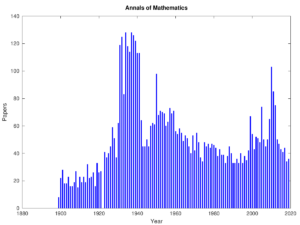
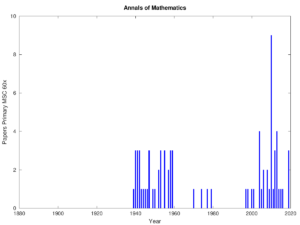
 Graphics for Acta Mathematica.
Graphics for Acta Mathematica.
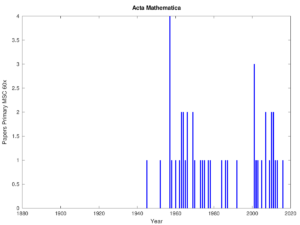
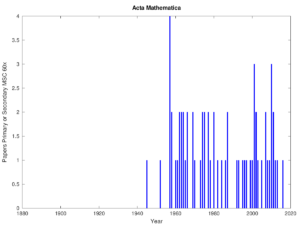 Graphics for Inventiones Mathematicae.
Graphics for Inventiones Mathematicae.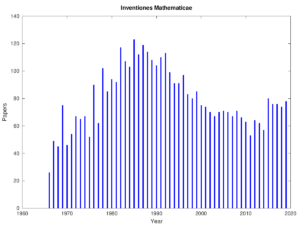
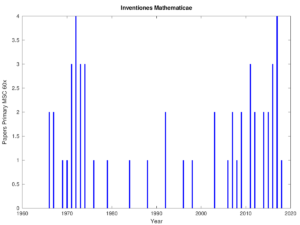
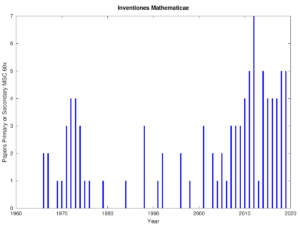 Graphics for Journal of the AMS.
Graphics for Journal of the AMS.
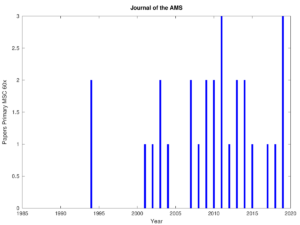
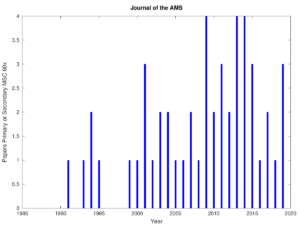
JMPA. We could think that a journal such as Journal de mathématiques pures et appliquées, founded in 1872, is in the same time relatively prestigious, generalist, and more open to applied mathematics in general and to probability and statistics in particular. Here is the data for all MSC codes, taken from MathSciNet. We see an obvious overweight for partial differential equations. In the mean time, the situation of probability is better than before, while the presence of statistics is still microscopic.
| MSC | Description | Count |
|---|---|---|
| 35 | Partial differential equations | 801 |
| 58 | Global analysis, analysis on manifolds | 138 |
| 53 | Differential geometry | 136 |
| 49 | Calculus of variations and optimal control; optimization | 107 |
| 46 | Functional analysis | 86 |
| 76 | Fluid mechanics | 69 |
| 14 | Algebraic geometry | 61 |
| 60 | Probability theory and stochastic processes | 60 |
| 93 | Systems theory; control | 58 |
| 30 | Functions of a complex variable | 57 |
| 47 | Operator theory | 55 |
| 32 | Several complex variables and analytic spaces | 53 |
| 34 | Ordinary differential equations | 43 |
| 37 | Dynamical systems and ergodic theory | 42 |
| 42 | Harmonic analysis on Euclidean spaces | 35 |
| 74 | Mechanics of deformable solids | 34 |
| 31 | Potential theory | 32 |
| 81 | Quantum theory | 24 |
| 82 | Statistical mechanics, structure of matter | 23 |
| 22 | Topological groups, Lie groups | 21 |
| 73 | Mechanics of solids | 21 |
| 20 | Group theory and generalizations | 19 |
| 83 | Relativity and gravitational theory | 19 |
| 36 | Other | 17 |
| 11 | Number theory | 16 |
| 45 | Integral equations | 16 |
| 28 | Measure and integration | 15 |
| 56 | Other | 12 |
| 10 | Number theory | 11 |
| 17 | Nonassociative rings and algebras | 10 |
| 26 | Real functions | 10 |
| 54 | General topology | 10 |
| 65 | Numerical analysis | 10 |
| 78 | Optics, electromagnetic theory | 10 |
| 27 | Other | 9 |
| 33 | Special functions | 9 |
| 48 | Other | 8 |
| 50 | Geometry | 8 |
| 92 | Biology and other natural sciences | 8 |
| 05 | Combinatorics | 7 |
| 43 | Abstract harmonic analysis | 7 |
| 91 | Game theory, economics, social and behavioral sciences | 7 |
| 09 | Other | 6 |
| 55 | Algebraic topology | 6 |
| 02 | Logic and foundations | 5 |
| 12 | Field theory and polynomials | 5 |
| 15 | Linear and multilinear algebra; matrix theory | 5 |
| 41 | Approximations and expansions | 5 |
| 16 | Associative rings and algebras | 4 |
| 44 | Integral transforms, operational calculus | 4 |
| 52 | Convex and discrete geometry | 4 |
| 57 | Manifolds and cell complexes | 4 |
| 62 | Statistics | 4 |
| 70 | Mechanics of particles and systems | 4 |
| 40 | Sequences, series, summability | 3 |
| 85 | Astronomy and astrophysics | 3 |
| 13 | Commutative algebra | 2 |
| 39 | Difference and functional equations | 2 |
| 71 | Other | 2 |
| 80 | Classical thermodynamics, heat transfer | 2 |
| 86 | Geophysics | 2 |
| 90 | Operations research, mathematical programming | 2 |
| 94 | Information and communication, circuits | 2 |
| 18 | Category theory; homological algebra | 1 |
| 79 | Other | 1 |
The same for the last three years:
| MSC | Description | Count |
|---|---|---|
| 35 | Partial differential equations | 154 |
| 49 | Calculus of variations and optimal control; optimization | 25 |
| 53 | Differential geometry | 19 |
| 14 | Algebraic geometry | 16 |
| 93 | Systems theory; control | 16 |
| 58 | Global analysis, analysis on manifolds | 12 |
| 42 | Harmonic analysis on Euclidean spaces | 8 |
| 37 | Dynamical systems and ergodic theory | 7 |
| 60 | Probability theory and stochastic processes | 7 |
| 76 | Fluid mechanics | 7 |
| 31 | Potential theory | 6 |
| 32 | Several complex variables and analytic spaces | 6 |
| 34 | Ordinary differential equations | 5 |
| 46 | Functional analysis | 5 |
| 81 | Quantum theory | 5 |
| 11 | Number theory | 4 |
| 47 | Operator theory | 4 |
| 74 | Mechanics of deformable solids | 4 |
| 28 | Measure and integration | 2 |
| 30 | Functions of a complex variable | 2 |
| 43 | Abstract harmonic analysis | 2 |
| 82 | Statistical mechanics, structure of matter | 2 |
| 83 | Relativity and gravitational theory | 2 |
| 92 | Biology and other natural sciences | 2 |
| 05 | Combinatorics | 1 |
| 12 | Field theory and polynomials | 1 |
| 15 | Linear and multilinear algebra; matrix theory | 1 |
| 20 | Group theory and generalizations | 1 |
| 26 | Real functions | 1 |
| 45 | Integral equations | 1 |
| 65 | Numerical analysis | 1 |
| 70 | Mechanics of particles and systems | 1 |
| 78 | Optics, electromagnetic theory | 1 |
| 86 | Geophysics | 1 |
| 91 | Game theory, economics, social and behavioral sciences | 1 |
| 94 | Information and communication, circuits | 1 |
CPAM. Finally, here is the same data for Communication on Pure and Applied Mathematics. This journal, established in 1948, is truly open to applied mathematics in general and to probability theory in particular. However, the presence of statistics is still extremely low.
| MSC | Description | Count |
|---|---|---|
| 35 | Partial differential equations | 898 |
| 76 | Fluid mechanics | 234 |
| 58 | Global analysis, analysis on manifolds | 182 |
| 60 | Probability theory and stochastic processes | 177 |
| 53 | Differential geometry | 97 |
| 65 | Numerical analysis | 92 |
| 82 | Statistical mechanics, structure of matter | 92 |
| 34 | Ordinary differential equations | 85 |
| 47 | Operator theory | 65 |
| 49 | Calculus of variations and optimal control; optimization | 64 |
| 37 | Dynamical systems and ergodic theory | 58 |
| 78 | Optics, electromagnetic theory | 58 |
| 20 | Group theory and generalizations | 49 |
| 46 | Functional analysis | 48 |
| 81 | Quantum theory | 43 |
| 10 | Number theory | 39 |
| 73 | Mechanics of solids | 37 |
| 30 | Functions of a complex variable | 29 |
| 36 | Other | 25 |
| 32 | Several complex variables and analytic spaces | 24 |
| 57 | Manifolds and cell complexes | 24 |
| 11 | Number theory | 23 |
| 74 | Mechanics of deformable solids | 23 |
| 94 | Information and communication, circuits | 22 |
| 42 | Harmonic analysis on Euclidean spaces | 20 |
| 03 | Mathematical logic and foundations | 15 |
| 31 | Potential theory | 15 |
| 45 | Integral equations | 15 |
| 62 | Statistics | 15 |
| 14 | Algebraic geometry | 14 |
| 55 | Algebraic topology | 14 |
| 70 | Mechanics of particles and systems | 14 |
| 83 | Relativity and gravitational theory | 14 |
| 92 | Biology and other natural sciences | 14 |
| 01 | History and biography | 13 |
| 15 | Linear and multilinear algebra; matrix theory | 13 |
| 52 | Convex and discrete geometry | 13 |
| 44 | Integral transforms, operational calculus | 12 |
| 22 | Topological groups, Lie groups | 11 |
| 26 | Real functions | 9 |
| 80 | Classical thermodynamics, heat transfer | 9 |
| 85 | Astronomy and astrophysics | 8 |
| 86 | Geophysics | 8 |
| 05 | Combinatorics | 7 |
| 43 | Abstract harmonic analysis | 7 |
| 12 | Field theory and polynomials | 6 |
| 28 | Measure and integration | 6 |
| 90 | Operations research, mathematical programming | 6 |
| 00 | General | 5 |
| 39 | Difference and functional equations | 5 |
| 68 | Computer science | 5 |
| 93 | Systems theory; control | 5 |
| 41 | Approximations and expansions | 4 |
| 91 | Game theory, economics, social and behavioral sciences | 4 |
| 02 | Logic and foundations | 3 |
| 17 | Nonassociative rings and algebras | 3 |
| 33 | Special functions | 3 |
| 09 | Other | 2 |
| 16 | Associative rings and algebras | 2 |
| 27 | Other | 2 |
| 40 | Sequences, series, summability | 2 |
| 54 | General topology | 2 |
| 69 | Other | 2 |
| 19 | K-theory | 1 |
| 51 | Geometry | 1 |